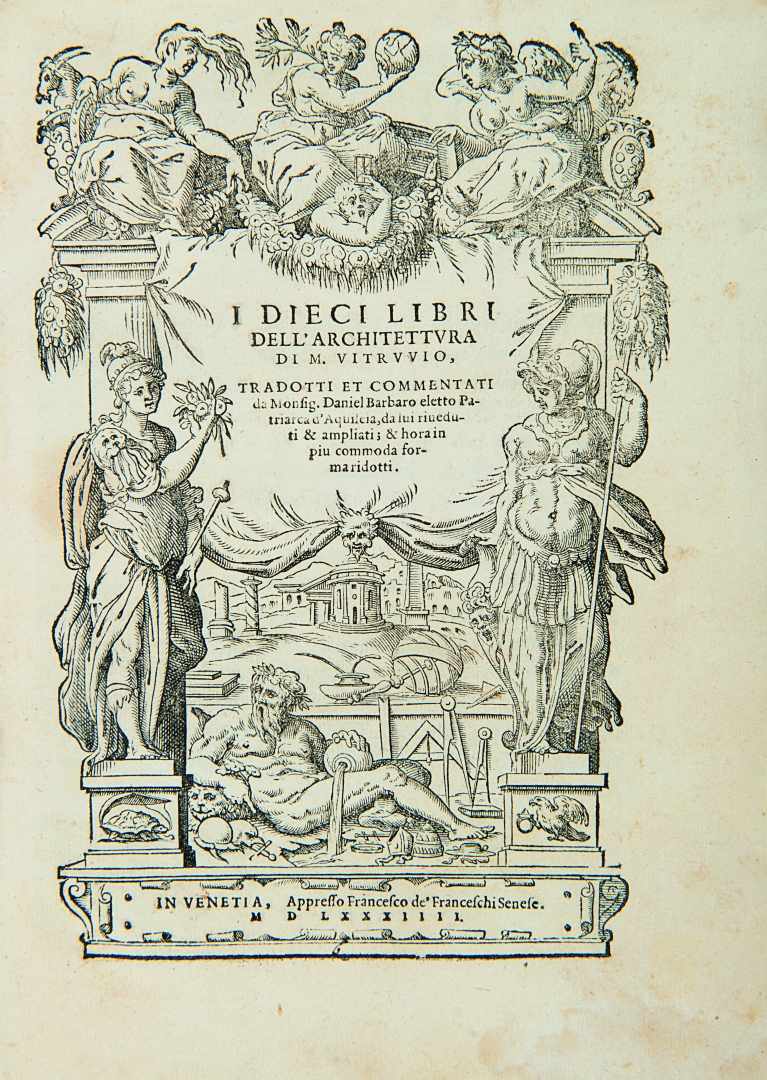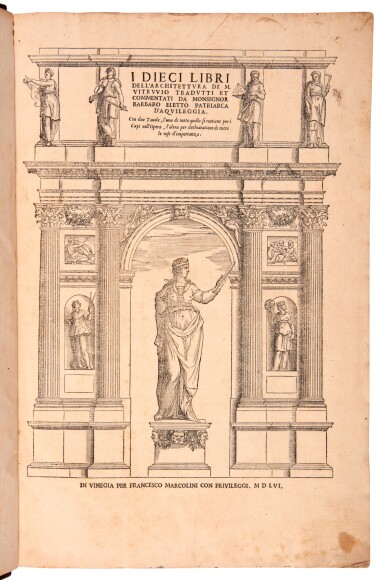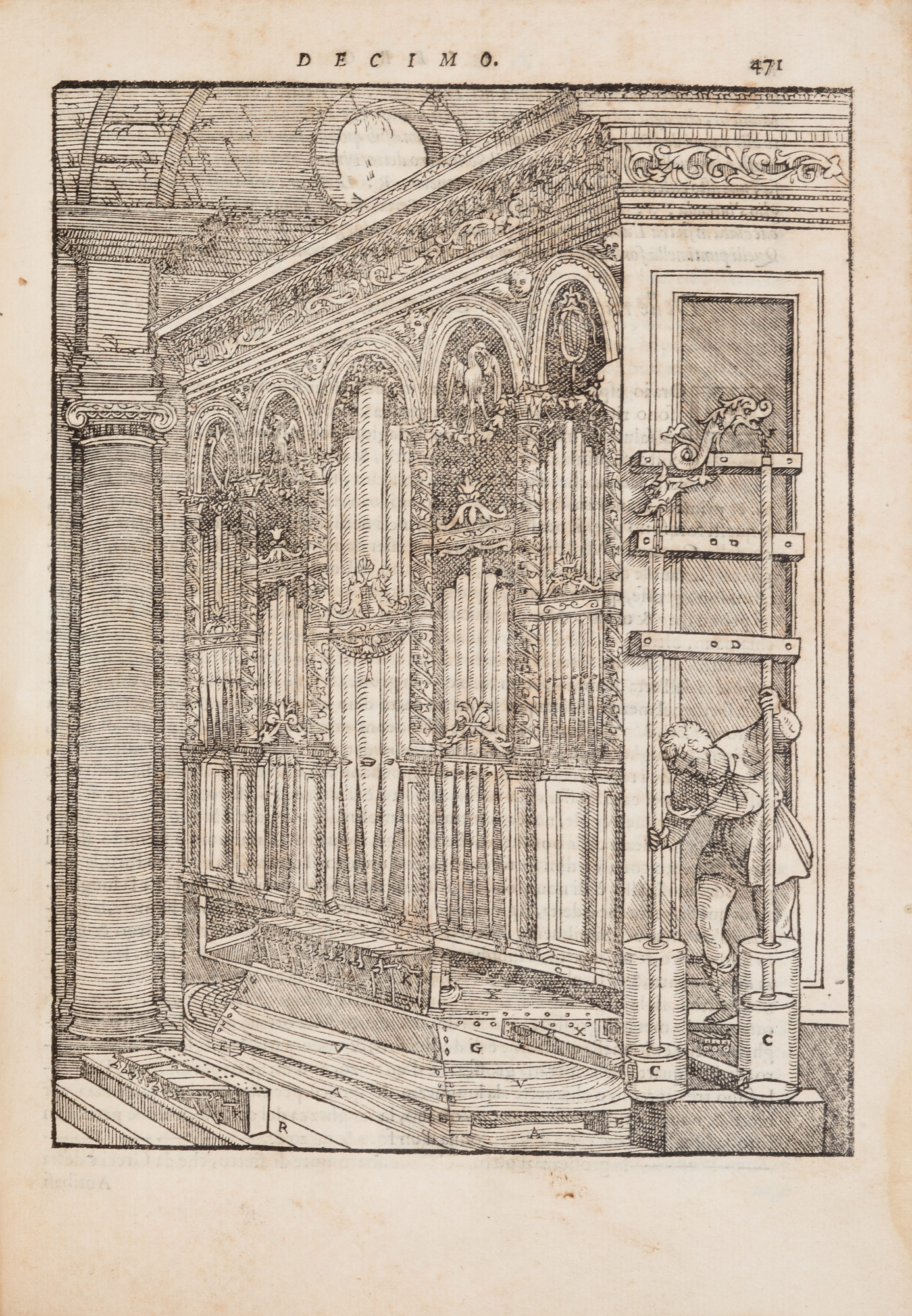VITRUVIO, Pollione Marco. I dieci libri dell’architettura. Venezia, Francesco Marcolini 1556 Folio, mm. 410x275; Contemporary vellum binding, spine with 4 ribs; pp. 274, i.e. 284, 18 not numbered, errors numbering; Pictorial Title page, 132 illustrations and diagrams of Giuseppe Salviati on the drawings by Andrea Palladio many at full page and 8 at double page; 6 copper plates C6r, E7r, E8r, F3v, I4r, I5r; 3 volvelles at leaf Q2v. V2v e V3r; two corrections with the application of plants at full page on pp. 72 e 85; to the last leaf, register with full-page illustration on the recto and a large printer's mark on the verso. Some pages with browning, first and last leaf with small wormholes, exemplary in good condition with wide margins.
First edition with the translation and commentary by Daniele Barbaro, beautifully Illustrated. It is to be considered among the best of the work Vitruvius, for both the Venetian humanist contribution both to the illustrations made by Palladio. Notable architect drawings are etched in woodcut by Giuseppe Salviati, artist of the Titian circle, and are taken from the original drawings of Palladio; furthermore, this is the first architectural work with volvelles and woodcut prolongations. Cellauro: “The original goal of the 1556 Italian edition of Vitruvius was to make available to architects who did not master Latin a reliable text of a lexicographical quality superior to that of the three preceding Italian translations published in 1521, 1524 and 1536, by including a faithful restitution of antique architecture as Vitruvius describes it. In other words, this publication aimed at combining the strictly philological and archeological study of Vitruvius' text with an annotation which would also act as an architectural treatise for contemporary practice. … The combination of Barbaro’s classical erudition and philological abilities and Palladio’s archeological and architectural expertise marks the peak of nearly a century of research on Vitruvius' text and confers great scientific value to this editorial collaboration.” Cicognara: “Magnifica edizione… Questa versione non solo al parere anche del Poleni, è da anteporsi ad ogni altra italiana che conservarsi, ma viene giustamente riputata per la prima veramente italiana.” Mortimer descrive alcune differenze tipografiche fra la ‘first’ e la ‘second copy Hofer”: questo esemplare presenta caratteristiche di entrambi le copie: alla carta B4v compare “Le” come nella “second copy”; nella prima K3r corrisponde invece alla “first copy Hofer”. Cicognara 713; Millard 160; Fowler 407; Mortimer, Italian 547. Louis Cellauro, Larhra, Lyon, 2010. The Lot is offered with a valid export licence.
VITRUVIO, Pollione Marco. I dieci libri dell’architettura. Venezia, Francesco Marcolini 1556 Folio, mm. 410x275; Contemporary vellum binding, spine with 4 ribs; pp. 274, i.e. 284, 18 not numbered, errors numbering; Pictorial Title page, 132 illustrations and diagrams of Giuseppe Salviati on the drawings by Andrea Palladio many at full page and 8 at double page; 6 copper plates C6r, E7r, E8r, F3v, I4r, I5r; 3 volvelles at leaf Q2v. V2v e V3r; two corrections with the application of plants at full page on pp. 72 e 85; to the last leaf, register with full-page illustration on the recto and a large printer's mark on the verso. Some pages with browning, first and last leaf with small wormholes, exemplary in good condition with wide margins.
First edition with the translation and commentary by Daniele Barbaro, beautifully Illustrated. It is to be considered among the best of the work Vitruvius, for both the Venetian humanist contribution both to the illustrations made by Palladio. Notable architect drawings are etched in woodcut by Giuseppe Salviati, artist of the Titian circle, and are taken from the original drawings of Palladio; furthermore, this is the first architectural work with volvelles and woodcut prolongations. Cellauro: “The original goal of the 1556 Italian edition of Vitruvius was to make available to architects who did not master Latin a reliable text of a lexicographical quality superior to that of the three preceding Italian translations published in 1521, 1524 and 1536, by including a faithful restitution of antique architecture as Vitruvius describes it. In other words, this publication aimed at combining the strictly philological and archeological study of Vitruvius' text with an annotation which would also act as an architectural treatise for contemporary practice. … The combination of Barbaro’s classical erudition and philological abilities and Palladio’s archeological and architectural expertise marks the peak of nearly a century of research on Vitruvius' text and confers great scientific value to this editorial collaboration.” Cicognara: “Magnifica edizione… Questa versione non solo al parere anche del Poleni, è da anteporsi ad ogni altra italiana che conservarsi, ma viene giustamente riputata per la prima veramente italiana.” Mortimer descrive alcune differenze tipografiche fra la ‘first’ e la ‘second copy Hofer”: questo esemplare presenta caratteristiche di entrambi le copie: alla carta B4v compare “Le” come nella “second copy”; nella prima K3r corrisponde invece alla “first copy Hofer”. Cicognara 713; Millard 160; Fowler 407; Mortimer, Italian 547. Louis Cellauro, Larhra, Lyon, 2010. The Lot is offered with a valid export licence.















Testen Sie LotSearch und seine Premium-Features 7 Tage - ohne Kosten!
Lassen Sie sich automatisch über neue Objekte in kommenden Auktionen benachrichtigen.
Suchauftrag anlegen